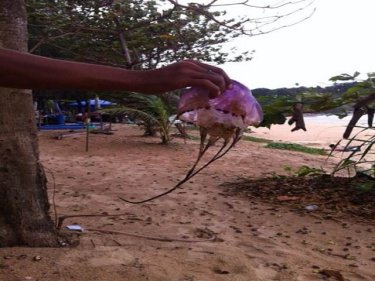PHUKET: Marine biologists are examining a jellyfish found at a Phuket beach but have confirmed it is not a deadly type known as a box jellyfish.
Lifeguards from Nai Harn beach were taking the specimen to the Phuket Marine Biology Centre at Cape Panwa today.
Based on photographs, marine biologist Piyawut Suktong said he believed the ''jelly'' was a Cnidaria Scyhozoa, a type that could cause irritation or itching but was not a danger.
Currents during the monsoon season tend to carry jellyfish to Nai Harn beach, the southernmost beach on Phuket.
A box jellyfish, one of the world's most deadly creatures, claimed a Thai tourist as a victim at a beach on Phangan island in the Gulf of Thailand last week.
However, the Isthmus of Kra separates the waters of the gulf from the Andaman Sea, where sightings of box jellyfish are occasionally reported but seldom confirmed by the capture of specimens and identification by experts.
It can be difficult for a non-expert to differentiate between toxic and non-toxic jellyfish specimens.
''Monsoon weather develops currents that take jellyfish further afield,'' Khun Piyawut said. ''There is no cause for alarm.''
Phuket and the Andaman Sea coast have occasionally suffered from jellyfish infestations in the past - including at Patong beach - but the plagues have ended within days.
Tranquil high season seas usually offer jellyfish free swimming on Phuket's west coast.
Lifeguards from Nai Harn beach were taking the specimen to the Phuket Marine Biology Centre at Cape Panwa today.
Based on photographs, marine biologist Piyawut Suktong said he believed the ''jelly'' was a Cnidaria Scyhozoa, a type that could cause irritation or itching but was not a danger.
Currents during the monsoon season tend to carry jellyfish to Nai Harn beach, the southernmost beach on Phuket.
A box jellyfish, one of the world's most deadly creatures, claimed a Thai tourist as a victim at a beach on Phangan island in the Gulf of Thailand last week.
However, the Isthmus of Kra separates the waters of the gulf from the Andaman Sea, where sightings of box jellyfish are occasionally reported but seldom confirmed by the capture of specimens and identification by experts.
It can be difficult for a non-expert to differentiate between toxic and non-toxic jellyfish specimens.
''Monsoon weather develops currents that take jellyfish further afield,'' Khun Piyawut said. ''There is no cause for alarm.''
Phuket and the Andaman Sea coast have occasionally suffered from jellyfish infestations in the past - including at Patong beach - but the plagues have ended within days.
Tranquil high season seas usually offer jellyfish free swimming on Phuket's west coast.













With all respect to this expert, I learned that whenever someone announces 'No Problem' in Thailand I am especially careful as there is a high chance something will happen....
Posted by Mr. K on August 6, 2015 13:53